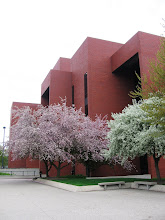The Sights & Sounds of Ball State University Libraries
During the academic year, the daily turnstile count for the University Libraries is about 7,400. Bracken Library and its two branches (Architecture Library and Science-Health Science Library) are filled with the sounds of collaborative learning.
These sounds are the voices of students asking librarians questions, conversations among students who are working collaboratively on projects, clicks from the keyboards, the whirl of the photocopy machines, the hum of high speed laser printers, and the greetings that people exchange among each other when seeing and being seen by classmates, fraternity/sorority members, acquaintances, and others.
There are sounds from cell phones, too, as students ask each other questions about assignments, make appointments, change their plans, and conduct other business.
Open 357 days during the year, the University Libraries offer students and faculty a wide array of library services 120.5 hours per week during the academic year, with a slightly reduced schedule when the university is not in session.
Students and faculty access the University Libraries’ print and digital collections, seek help from librarians with their assignments and projects, prepare papers and analyses using one of the 350 public PCs, and they print their projects or store them in an iLocker digital storage space – all through the University Libraries. Of course, books, journals, CDs, DVDs and other items are popular for check-out. The University Libraries offer comfortable space for collaborative and individual study and a number of small to large group study rooms for practicing presentations and listening/viewing assigned materials for music and cinema classes.
Over the past four years, the Libraries’ professional, paraprofessional, and administrators have engaged to transform the University Libraries to a “place” for research, learning, and friends.
By emphasizing the University Libraries’ strong customer-oriented student and faculty services, by observing how students use space for collaborative and individual learning, and by introducing sophisticated technology for research and learning, the result is a growth of 151% in traffic as measured by turnstile count for the 5 fiscal years between 2001-2002 (840,766 visits) and 2005-2006 (1,269,412visits).
The University Libraries’ turnstile count continues to increase, showing that students and faculty choose the University Libraries as the place for their research and learning. At the same time, our Libraries’ professional, paraprofessional, and administrators continue our strategic planning to further enhance the Libraries to provide more services, for the University Libraries to actively and increasingly contribute to the academic life of the university.
Approximately the size of seven football fields, Bracken Library offers plenty of space for the quiet and not-so-quiet crowds. For example, the fourth floor is designated as a Quiet Zone.
The hum of students is noticeably low on Bracken’s second floor and on the basement level. Bracken’s first and third floors are known to students as places to see and be seen, where students can work alone – yet welcome interruptions – or collaborate with others on papers and projects. There is lots of space for individual study, too.
The chart shows the average number of persons who entered Bracken Library during the 40-day period between August 22 and September 30, 2006. There were an average of 64 persons who passed through the turnstiles between 7 a.m. and 8 a.m. and 132 persons between 8 a.m. and 9 a.m. The turnstile meters are read each hour. Of course, some people were entering and others were exiting. A count of 64 means that 64 persons entered or exited or both.
The data from which the chart was made show that 51,794 persons or 28.2% of the 183,792 persons counted during the 40-day period visited Bracken Library before noon, 49,151 or 26.7% visited between noon and 3 p.m., and 43,923 or 23.9% between 3 p.m. and 7 p.m. for a total of 78.8% of visits. This is useful information for offering the Libraries’ programs and services.


0 Comments:
Post a Comment
<< Home